Guest speaker accused of Islamophobic remarks sparks response, calls for action
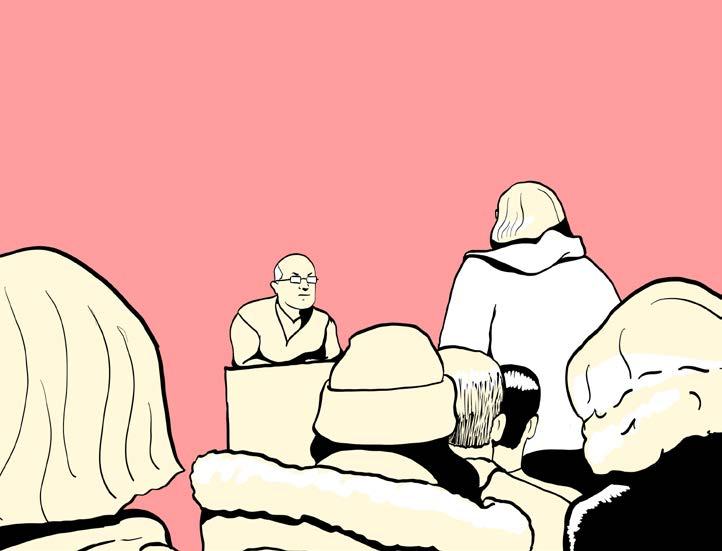
Gillian Brown and colton McKillop, staff asked the guard why the keffiyeh would indicate they would cause trouble.
Haneen Nakhleh and Belkis Elmoudi attended Bassem Eid’s talk on campus last Monday. Before even walking into the room, they felt unwelcome.
When Nakhleh, her sister Ronia and Elmoudi — who had all registered for the event prior — tried to enter the event, they said campus security had asked if they had registered three separate times.
Nakhleh remembers a security guard asking the three women if they were going to “cause any problems.”
Elmoudi noted that all three wore hijabs. Nakhleh had a keffiyeh on her backpack, which the guard noticed. They were only let in after Nakhleh
News 3
Dean is done
Former law dean disbarred by Manitoba Law Society
“We walk in, we were given dirty looks,” she recalled. “We took our seats in the back, and just listened.”
During the question period, Elmoudi raised her hand and asked a question, which was delayed to the end by Eid, but before he reached her question, another question was asked, about how Christians, Jews and Muslims can achieve peace. In Eid’s response, he said the major obstacle was “the ideology of Muslims.” He said Muslims are ideologically “not ready to change.”
The three felt as though couldn’t say anything. They said they had been threat-
Editorial 8
Flight of the photographers
Being near death provokes profound thoughts
ened with arrest just before sitting down, but eventually, Elmoudi stood up to tell the audience that what they were hearing was misinformation. Eid raised his voice, telling her to stop talking, and then addressed the audience, saying that “this is the problem of the Muslims.”
The group left soon after another attendee spoke up.
“It made me feel very isolated and very unsafe,” Elmoudi said.
Elmoudi said that, after the event, security services reached out to say Eid’s conduct at the event was “appalling.” The three made clear, though, that the message did not acknowledge security’s behaviour.
U of M said security ser-
Comment 11
Hall of fumbles
UMSU, UM continue to ignore anti-Palestinian racism
vices was unavailable for an interview, but provided an email statement to the Manitoban which said the onus is on event organizers to engage security services “if they feel security services are needed for the event,” in order to create a safety plan.
The statement also said U of M policies for the space and event are explained to event hosts, drawing attention to the Respectful Workplace and Learning policy, and that the policies apply to everyone in attendance.
The community reacts
A day after the event was held, Elmoudi took to social media to share her story. She was flooded with comments
Arts & Culture 15
Showtune showcase
UM theatre ensemble celebrates “La Vie Boheme”
of support, with many calling to hold UMSU and the University of Manitoba accountable for allowing the event to be held on campus.
While the talk was held at the U of M, both UMSU and the university emphasized in email statements to the Manitoban that they were not involved with its organization. The event was organized by the groups Students Supporting Israel (SSI) and Bridges for Peace, with funds from the Asper Foundation.
Cont’d p. 4 / Student >
Sports
Women’s V-ball win
Bisons women heading to CanWest finals
March 06, 2024 VOL. 110, NO. 24 SINCE 1914
16
graphic / Dallin Chicoine / staff
Vol. 110

EDITOR-IN-CHIEF Gillian Brown editor@themanitoban.com
BUSINESS MANAGER vacant accounts@themanitoban.com
ADVERTISING CO-ORDINATOR Diego Castro ads@themanitoban.com
EDITORIAL
MANAGING EDITOR vacant me@themanitoban.com
COPY EDITOR Simon Pensato copy@themanitoban.com
COPY ASSOCIATE Paula Samaniego-Ayllon
NEWS EDITOR Sarah Cohen news@themanitoban.com
NEWS EDITOR Colton McKillop news@themanitoban.com
RESEARCH & TECHNOLOGY EDITOR Elah Ajene research@themanitoban.com
COMMENT EDITOR Jessie Krahn comment@themanitoban.com
ARTS & CULTURE EDITOR Jacob Davis arts@themanitoban.com
SPORTS EDITOR Joshua Brandt sports@themanitoban.com
DESIGN
DESIGN EDITOR Taeran An design@themanitoban.com
DESIGN ASSOCIATE Deveney Jarrow
GRAPHICS EDITOR Teegan Gillich graphics@themanitoban.com
GRAPHICS ASSOCIATE Dallin Chicoine
AUDIO AND VIDEO
AUDIO EDITOR Harmatpreet Brar audio@themanitoban.com
PHOTO EDITOR Ebunoluwa Akinbo photo@themanitoban.com
PHOTO ASSOCIATE Matthew Merkel
VIDEO EDITOR vacant video@themanitoban.com
SOCIAL MEDIA EDITOR Violet Baker social@themanitoban.com
REPORTERS
NEWS Alicia Rose
NEWS Kyra Campbell
RESEARCH & TECHNOLOGY Rhea Bhalla
COMMENT Braden Bristow
COMMENT Lakshmisree Shaji
ARTS & CULTURE Kelsey Chin
ARTS & CULTURE Alison Holliday
SPORTS Quinn Mayhew
VOLUNTEER STAFF
Bahareh Rashidi, Christina Tran, Romin Cheema
Adam Johnston, Michele Melendez
VOLUNTEER
Allie Stone interested in volunteering? email me@themanitoban.com today!
109
UNIVERSITY OF MANITOBA
WINNIPEG, MB
204. 474. 6535
The Manitoban is the official student newspaper of the University of Manitoba. It is published monthly during the summer and each week of regular classes during the academic year by the Manitoban Newspaper Publications Corporation.
The Manitoban is an independent and democratic student organization, open to participation from all students. It exists to serve its readers as students and citizens.
The Manitoban is a member of the Canadian University Press, and our journalistic standards can be found on the Manitoban’s website.
The newspaper’s primary mandate is to report fairly and objectively on issues and events of importance and interest to the students of the University of Manitoba, to provide an open forum for the free expression and exchange of opinions and ideas and to stimulate meaningful debate on issues that affect or would otherwise be of interest to the student body and/ or society in general. The Manitoban serves as a training ground for students interested in any aspect of journalism.
Students and other interested parties are invited to contribute to any section of the newspaper. Please contact the appropriate editor for submission guidelines.
The Manitoban reserves the right to edit all submissions and will not publish any material deemed by its Editorial Board to be discriminatory, racist, sexist, homophobic or transphobic, ableist or libellous.
Opinions expressed in letters and articles are solely those of the authors. Editorials in the Manitoban are signed and represent the opinions of the writer(s), not necessarily those of the Manitoban staff, Editorial Board or the publisher.
A “volunteer staff” member is defined as a person who has had three volunteer articles, photographs or pieces of art of reasonable length and/ or substance published in the current publishing year of the Manitoban.
Any individual who qualifies as a volunteer staff member must be voted in by a majority vote at a Manitoban editorial board meeting. Elected representatives and non-students may be excluded from holding votes as volunteer staff members in accordance with the Manitoban Constitution.
All contents are ©2024 and may not be reprinted without the express written permission of the Editor-in-Chief.







THEMANITOBAN.COM
HELEN GLASS BUILDING
2
No. 24
VOLUNTEERS
News pages 3 to 4 Research & Technology pages 5 to 6 Editorial page 8 Comment pages 10 to 13 Diversions page 14 Arts & Culture pages 15 Sports page 16
Former law dean disbarred for misuse of university funds
Black-Branch to pay fine, current dean implements new accounting protocols
colton McKillop, staff
F ormer dean of U of M’s faculty of law Jonathan Black-Branch was disbarred and fined $36,000 last month for misappropriating more than half a million dollars of university money in a series of expenses the Manitoba Law Society described as fraudulent.
A Law Society of Manitoba disciplinary panel decision in December found that BlackBranch misappropriated university funds to pay for accommodations, meals, education and travel expenses while he was dean at Robson Hall.
The panel noted that law society counsel did not seek restitution from Black-Branch for any of the costs he incurred to the university. The counsel pointed out that U of M has reimbursed the Desautels fund’s losses out of its own budget and said the university could seek civil remedies from Black-Branch.
Misused funds included money taken from a university endowment fund meant to support the faculty’s Desautels Centre. Black-Branch served as chair and director of the centre at this time.
new accounting protocols to prevent future abuses.
“A simple change — but it’s significant — is everyone has a one-over approval, which basically means a higher rank than you has to approve your spending,” he said.
As dean, Black-Branch was able to approve his own expense claims. Moving forward, the university will improve accountability measures by checking the dean’s expenditures quarterly instead of yearly, as was the case during Black-Branch’s tenure.
Documents from BlackBranch’s disciplinary hearing stated that the panel found the evidence against BlackBranch so strong that “even if the standard had been the criminal standard of beyond a reasonable doubt, the Panel would have been satisfied that proof was sufficient.”
Leah Kosokowsky, the law society’s CEO, called Branch’s
lic’s confidence in the law society’s ability to regulate lawyers,” she said.
U of M administration waited until after details emerged from Black-Branch’s disciplinary hearing to seek criminal or civil charges against Black-Branch, an approach that drew criticism from U of M philosophy professor Arthur Schafer and five U of M law professors who signed a letter to police on Dec. 21 asking them to pursue legal action.
The university asked police to investigate Black-Branch shortly after.
Jayden Wlasichuk, president of the Manitoba Law Students’ Association, said “there is a lot of hurt right now in the faculty,” as many had friendships with Black-Branch before his activities were revealed, as well as people who “have been very vocal about” the need for an investigation.
“It is the ultimate penalty that you can be subjected to as a lawyer, because it essentially ends your career”
— Leah Kosokowsky, Law Society of Manitoba
CEO
Current dean of U of M’s law faculty Richard Jochelson noted that the university has implemented a number of
actions “a significant breach of integrity.” She said the law society’s intention with its verdict was not to punish, but “to protect the public interest.”
“It is to preserve the pub-
In contrast, she noted that since the law program is only three years, many current students have never met Black-Branch, including her.
“This seems both far away and also right in the middle of our faculty, because people have been talking about it for so long and there’s been so much discussion,” she said.

“But [for] most of us, it’s this figure we’ve never met or really heard of until this,” she said. As a result of his disbarment, the law society has removed Black-Branch’s name from its rolls of solicitors and barristers.
Kosokowsky said that disbarment is “not very common at all,” and noted that it is reserved for the “most serious of conduct.”
“It is the ultimate penalty that you can be subjected to as a lawyer, because it essentially
ends your career,” she said.
In order to practice law in another jurisdiction in Canada, Black-Branch would be required to disclose the fact that he had been disbarred.
Law student Peter Frejek was not enrolled during BlackBranch’s tenure. He called the situation “really unfortunate.”
“The legal profession is supposed to be one that takes integrity and personal and professional reputation quite seriously, and this does seem to be a not great reflection on that,” he said.
Request to hear amendments to motion banning student from UMSU meetings ruled out of order
Judicial board’s motion to bring Romero’s appeal to board of directors denied
Sarah Cohen, staff
A motion to allow amendments to a motion that suspended student-at-large Victoria Romero from UMSU meetings was ruled out of order.
Motion 0598, brought forward by the judicial board at the Feb. 29 board of directors (BoD) meeting, requested that the board hear amendments to motion 0594, which suspended Romero from meetings following a vote by the BoD on Jan. 25.
After a ten minute recess, the UMSU chair of the board Elbethel Masresha announced that she was ruling the motion out of order. During the chal-
lenge to the ruling that followed, Masresha called the motion “redundant.”
The “judicial [board] is [...] giving themselves more power than they are permitted,” she said.
As of now, UMSU’s governance and operations manual describes the judicial board’s mandate as receiving and evaluating complaints and appeals of elected and appointed UMSU members and committees. It is also responsible for hearing appeals of motions from UMSU members Rohan Sethi, judicial board chairperson, said the board presented the motion “so that
the board of directors does not feel that we are superseding or stepping out of our jurisdiction” regarding the appeal process for UMSU’s safe environment policy.
Sethi said motion 0594 was brought forward on Jan. 25 by judicial board because “the governance and operations manual did not describe procedure on how to adequately address the situation we all recognize as quite unprecedented.”
Masresha said the motion undermines the current rules in UMSU’s governing documents.”
“What [the judicial board] are trying to do is contra-

the procedure already laid out for them to make decisions,” she said. The BoD voted to sustain the chair’s ruling in a nine to
3 news@themanitoban.com March 06, 2024 News
graphic / Teegan Gillich / staff dicting
five majority, meaning that amendments to Romero’s appeal will not be heard or voted on by the board.
photo provided
Indigenous internship applications open this month
U of M offers Indigenous students internship opportunities over the summer
alicia rose staff
Indigenous students at the University of Manitoba can apply to the Indigenous summer student internship program on March 8.
René Ouellette, who is Inuit, is the associate vice president (human resources) at the U of M. The program, ISSIP, began in 2018. Ouellette said the program “offers opportunities for Indigenous students who will be coming back in the fall to work in a number of areas at the university.”
Ouellette said students have been placed in departments including health services, education, agriculture and food sciences, biology, marketing and communications and more.
Students who apply to the program are placed in positions based on their academic background by human resources and faculties.
In addition to the work experience, the program involves “cultural days” in which students can take part in teachings with Elders and
medicine picking. Ouellette said this makes it a “holistic placement and opportunity” for students involved.
Ouellette said the program is a “good opportunity” for Indigenous students at the university, as it allows them to “see the university from a different lens.”
“I think it’s important as part of our overall reconciliation action plan,” he said. “[It] helps with our Indigenous students and Indigenous staff to, again, build that community and move forward in a good way,” said Ouellette.
Ishkode Catcheway, UMSU Indigenous students’ representative and a previous summer internship participant, said the program is a “good opportunity” for students. She said anyone can benefit from it because of its variety in programming.
Catcheway said her experience at the National Centre for Truth and Reconciliation (NCTR) helped her in her studies and future as it was her first time being involved
in research.
“I really liked getting the experience that I got working at the NCTR,” she said. Catcheway said she will always carry “what [she] learned there from Elders and from survivors,” both in the program and from her research in the archives.
She said the teachings she learned in the program allowed her to see research differently, as it was done through an “Indigenous lens,” compared to a colonial mode of research, which is common in universities. She plans to pursue a masters of community health, and research the Indigenous adult and youth suicide crisis in Manitoba.
Catcheway said the friends and connections she made throughout the program, and the ISSIP’s professional development days, allowed her to learn more about the other students’ research in the program,
The program starts on May 6, and lasts for 16 weeks. Students accepted will be working 35 hours a week in pos-

itions in their given department. This year, there are eight internship positions available for eligible students to fill.
More information and resources will be available to students on UM Careers on
March 8.
— with files from Michaela de Hoop
Student group responsible for event suspended from UMSU pending investigation
Eid — referred to on posters promoting the talk as a “Palestinian peace activist, human rights expert, political analyst and journalist” — spoke at the U of W earlier that day. That event was presented by Bridges for Peace and Jewish Community on Campus, assisted again by the Asper Foundation.
When asked why SSI invited Eid to speak on campus, SSI U of M president Tomer Hatzir and SSI founder and international president Ilan Sinelnikov said in an email that they “were unaffiliated” with the original event in which Eid came to speak. The two did not take responsibility for inviting him — nor did SSI U of M collectively on its Instagram statement. They said he came to the U of M because of his perspective as “someone who identifies as a Palestinian Muslim peace activist.”
unexpected answer.”
In a statement from Eid provided by SSI, Eid said that he meant to refer to Muslims who hold supremacist views, rather than generalizing all Muslims. He also said that, in his view, the majority of Muslims seem to hold beliefs “contrary to peace and coexistence.” He emphasized that his beliefs are his own.
UMSU president Tracy Karuhogo declined a request for interview, but the union released a statement on its Instagram which condemned Islamophobia, and apologized to the students who faced “this horrific act of discrimination” at the event.
the university denounces Islamophobia, and that the event “does not reflect UM’s values.”
The statement said that the U of M supports UMSU’s banning of Eid from UMSU spaces. Regarding other university spaces, it said that “UM is focused on other actions to protect and support students,” and that there are conversations happening to determine next steps.
Student group suspended
Elmoudi said the suspension was “the right choice to make.”
“This was a good time for the student union to stand with the student body collective in ways that it hasn’t throughout this,” she said.
With the exception of the student union, Elmoudi said the group has not received an apology from anyone — including SSI, which commented on Elmoudi’s post, telling her that if she had stayed, she would have heard Eid walk back on his statement.
Eid “a disgrace to [his] people” and left the room. He was later recorded being followed by a U of M security car down Markham Road, just off campus.
The two suggested that Eid’s comments were a result of “verbal abuse” that took place at the talk, and said that no similar comment had been made by Eid at the U of W or anywhere else.
Following the event, UMSU suspended SSI as a club under the union, pending ongoing investigation.
“If the university is not willing to censor groups, why are they willing to censor individuals?”
— Belkis Elmoudi, U of M student
Hatzir and Sinelnikov said in their email that they “do not agree with [Eid’s] initial
The union has banned Eid from UMSU spaces — which, on the Fort Garry campus, is limited to University Centre and the first level of Helen Glass. Its statement said it is currently working with the university to make sure that Eid is barred from all spaces at the U of M moving forward.
When asked for an interview, U of M spokesperson Eleanor Coopsammy provided a written statement on behalf of the U of M that said
Hatzir and Sinelnikov said “by revoking SSI’s status, UMSU is not only silencing the voice of a minority group […] but is also causing dismay among those who value free speech and open discourse on campus and in Canadian society.”
They claimed that the process and reasoning supporting the suspension is “not valid at all,” and said they will fight the decision. SSI said it was not given the chance to engage with the union prior to receiving the notice.
In the club’s comment, it said it disagreed with Eid’s generalization, and that it “perhaps arises from his lived experience.”
A continuing concern
What Elmoudi and her friends experienced at Eid’s talk is not an isolated incident for Muslim and Palestinian students on campus. Ronia, secretary for Students for Justice in Palestine (SJP), said the members of the group often feel surveilled by campus security. She said her experience at the event “confirmed the fact that security was there to surveil us, not protect us.”
One Palestinian teen who does not attend the U of M walked into the talk, called
Following the event, SJP met with vice-provosts Laurie Schnarr (students) and Tina Chen (equity), along with Elmoudi, Arij Al Khafagi — who was recently suspended from the university for posting a series of posts on her personal social media criticizing Israel, and was later reinstated — and the Muslim Students’ Association, which Elmoudi said was “a really good foundational step.”
Elmoudi criticized the U of M’s failure to mention anti-Palestinian racism or the event’s organizers in its statement — which was circulated to students and published on UM Today — and that it did not involve any acknowledgement of accountability.
Elmoudi said that at the meeting with the U of M, the administration said it should not censor any “diverse opinions.”
“I don’t really consider hate speech as falling under ‘diverse,’” she said.
She pointed to Al Khafagi’s case. “If the university is not willing to censor groups, why are they willing to censor individuals?”
4 news@themanitoban.com Vol. 110, No. 24 News
photo / Faith Peters
< Cont’d from front page
Research & Technology
The joys and challenges of marriage
U of M assistant professor talks building a happy marital relationship
Rhea Bhalla, staff
The Thriving Center of Psychology found in a 2023 survey that 83 per cent of Generation Z and millennials would like to get married at some point in their lives. Yet with nearly half of people in relationships no longer believing in the institution of marriage, marriage rates have plunged in recent decades in Canada. One reason for this may be the fact that around 40 per cent of marriages nationwide end in divorce.
Michelle Jonathan, assistant professor in the U of M’s faculty of social work, explores relationship dynamics in marriage in her research.
“You always hear jokes saying getting married is like jumping into a well,” Jonathan said. “Whoever is outside the well wants to jump inside, and whoever is inside the well wants to come outside.”
“The truth is there is joy in marriage,” she said.
In a 2021 article, Jonathan explored marriage enrichment programs, which reduce the likelihood of couples separating or divorcing up to five years after completing the program.
Though they began as “faith-and community-based programs,” marriage enrichment programs are now commonly offered as public and private counselling. The programs focus on helping couples build the skills necessary to support their partner’s needs by negotiating clear and equitable expectations and roles.
The article states that “healthy marital relationships create happy adults, happy couples have happy children, happy adults and children build a healthy society.”
Jonathan explained how people may perceive struggles in their marriage or flaws in their partner that do not actually exist.
“It’s kind of like an onion,” Jonathan said.
“We peel, and peel and peel and at last we see there is nothing.”

by simply talking to each other. In between work and children, it becomes difficult for some couples to carve out quality time together.
their personality is being insulted, they are less likely to reflect upon and modify their behaviour. Generalized criticism, Jonathan noted, is simply not productive.
“The truth is there is joy in marriage”
— Michelle Jonathan, U of M assistant professor in the faculty of social work
These false perceptions may begin as seeds planted by the people around us.
If, for example, a wife calls her husband multiple times while he’s out, his friends may remark that she’s annoying. The husband may then internalize these ideas, truly believing his wife is annoying.
Jonathan explained that many issues can be resolved
“When we ask, they don’t even feel that there is a need to spend some time together at least once in a day, maybe 20 or 30 minutes,” she said.
Jonathan also underscored the importance of phrasing criticism in a thoughtful way.
“When we speak in a generalized way, we are attacking their personality, rather than their action on that particular occasion,” she explained.
When someone feels that
“[When we] understand unnecessary patterns of communication, it makes our relationships more beautiful and more meaningful,” she said.
A 2018 study Jonathan co-authored in 2018 looked at the impact of technology in marital relationships among a participant group of married heterosexual couples under the age of 50.
The study found that using a laptop separately while in the presence of a partner negatively affected relationships.
In contrast, watching television together is correlated with a positive perception of the relationship. The authors explained that technology can be beneficial or detrimental “depending on the couple’s ability to manage, monitor, and reflect on its use.”
Jonathan noted that many marriages, though stable, are not sufficiently harmonious or intimate.
In the past, many couples did not feel the lack of intimacy that strains many marriages today. Jonathan noted that this is due to past generations having different needs for intimacy. Today, perceptions around intimacy have changed, leading to more people feeling that their intimacy needs are not met.
“Our thoughts have changed, our ideologies have
changed, but our actions and behaviours have not changed,” she said. “The need for intimacy is different, but the behaviours [providing] intimacy are not matching it.”
Husbands often behave as they saw their fathers behave when they were growing up, while wives similarly behave like their mothers. Yet the level of intimacy demonstrated by parents is often not enough. Jonathan expressed that it is important for people to understand they may need to change their ways of connecting with their partner.
“Your marriage is like a garden,” Jonathan said. “There will be weeds coming in.”
5 research@themanitoban.com March 06, 2024
graphic / Michele Melendez / volunteer staff
Toward new frontiers in cellular biology
New project to explore the role of extracellular vesicles in disease
Elah Ajene, staff
Last month, Research Manitoba’s Innovation Proof-of-Concept (IPoC) Grant Program allocated close to $550,000 in funding over the span of two years to support five research initiatives at the University of Manitoba. Among the recipients is associate professor in the faculty of kinesiology and recreation management Ayesha Saleem.
Saleem is a principal investigator at the Children’s Hospital Research Institute of Manitoba. Her research focuses on cellular biology and its implications for understanding childhood health and diseases.
Currently, her research endeavours revolve around extracellular vesicles (EVs) — nano-sized particles that play crucial roles in intercellular communication within the body, typically by carrying various types of molecules.
Saleem and her team are investigating how EV-mediated signalling impacts mitochondrial function across various health and disease models. This includes studying EVs derived from exercise, aging and metabolic disorders like Type 2 diabetes and obesity.
“We’re doing this because we believe this EV-mediated signalling between cells and between organ tissues within a body is regulating the interplay between the host tissue, as well as in post challenges,” she explained.
Additionally, Saleem is exploring the potential diagnostic utility of fetal EVs for rare genetic diseases affecting children.
“We’re trying to approach and determine whether environmental and developmental conditions, like breastfeeding during early childhood or asthma development, can be linked with EVs in the breast milk,” she explained.
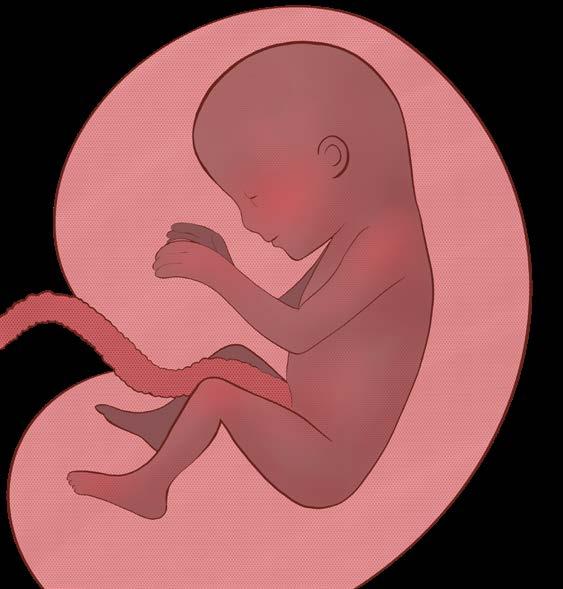
lighting that certain conditions, such as pediatric mitochondrial disease, pose significant challenges in diagnosis.
“You never know who’s holding the secrets or the cure to the next disease in their mind”
markers for mitochondrial disease by isolating EVs from human patients with the disease to scrutinize their composition and evaluate their suitability as diagnostic indicators.
— Ayesha Saleem, U of M associate professor in the faculty of kinesiology and recreation management
Saleem’s upcoming project, funded by the IPoC Grant Program, would investigate the feasibility of using EVs as diagnostic biomarkers for mitochondrial disorders during prenatal and postnatal stages.
“It’s a very innovative and unique proposal and we are trying to see if fetal EVs can be used to tell us if the fetus has any kind of genetic disease,” she said.
Saleem noted the significance of this research, high-
Her project has two primary objectives.
Firstly, it aims to establish concrete evidence that demonstrates the transfer of fetal diseases into the maternal circulation system, employing advanced experimental transgenic models (genetically modified animal models) and cutting-edge molecular techniques.
Secondly, Saleem aims to assess the potential of EVs as
Saleem’s journey as a researcher began at York University, where she pursued her undergraduate and master’s degrees before completing her PhD at the same institution. Following this, she did her postdoctoral fellowship at McMaster University — delving into the intricate mechanisms underlying mitochondrial biogenesis and its relationship with exercise-induced physiological challenges, particularly focusing on the tumour suppressor protein p53.
In discussing her motivation for this research, Saleem highlighted her lifelong fascination with science and the mentorship she received from influential researchers such as York University researcher David Hood.
“I remember sitting in my fourth-year exercise physiology class at York University and just being absolutely fascinated by my professor, and he actually went on to become my master’s and PhD advisor,” she recalled.
Ultimately, the researcher finds inspiration from a variety of sources — including scientists who have advanced research, as well as her family, friends, colleagues, mentors and teachers. She particularly highlighted her father’s strong work ethic and her sister’s support in keeping her motivated.
“I’m blessed and lucky to be surrounded by so many
people who inspire me to keep moving forward,” she said.
Saleem advises students that while experience and knowledge are helpful, nothing can replace internal drive and passion.
She stressed the importance of students’ wholehearted dedication and perseverance in pursuing their goals, regardless of the field.
“We are lucky enough to be in a place and […] privileged to be in a position where we can investigate cellular biology and physiology and really find new knowledge, as well as ensure that our results can help people and others,” Saleem said.
“You never know who’s holding the secrets or the cure to the next disease in their mind, they just have to be exposed to research.”
6 research@themanitoban.com Vol. 110, No. 24 Research & Technology
graphic / Teegan Gillich / staff

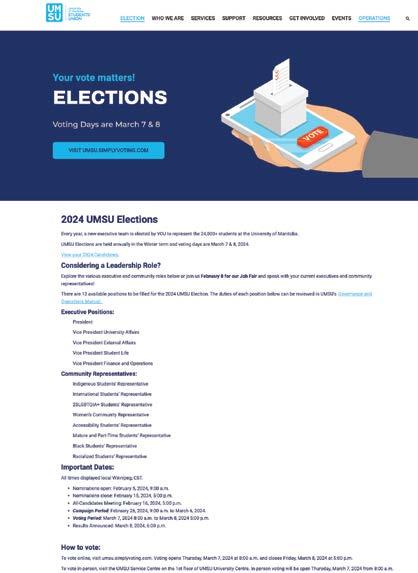

MAKE YOUR VOICE HEARD! Vote for the candidate that resonates with you. w YOUR VOTE MATTERS! CAST YOUR VOTE MARCH 7-8, 2024 General Election Information Information on Election Candidates UMSU.SIMPLYVOTING.COM umsu.ca/elections www.UMSU.ca @myumsu
The fragility of life
Near-death experiences make us reflect on mortality
Ebunoluwa Akinbo, staff
In the delicate fabric of existence, life is like a thin thread and a fragile dance between breaths. With constant reminders that our presence here is transient, the next heartbeat is never promised. Our lives quickly unfold, whether it takes four weeks or a century, reminding us to grab onto the moments before they turn into memories in the blink of an eye.
Death is like a quiet companion with us on our journey through life, waiting to provide support at any time on the journey it decides one needs eternal rest. Death is something we all share, the one thing that is certain in our uncertain trip through time.
Amid the ephemeral nature of our existence, there lies an unparalleled beauty in the mundane. It’s in the sunrise that graces each morning and the shared laughter that echoes through the ordinary moments of our daily lives. It’s in the smell of our loved ones or the smell of the first rain in the hot summer.
When I think of death, it dawns on me that the essence of birth is not just death, but dying empty, having exhausted my gifts, talents, skills and knowledge. I have an imagination of how I want to die: not in the cold, not with a bra on, not on a vacation and not on a road trip. Maybe I’ll die with a pair

of socks on because I get cold from my feet. I think knowing when and how one will die is a privilege in itself, a six-month notice can ensure the best six months of one’s life.
My closest near-death experience was on a plane trip from Maiduguri, northern Nigeria, to Lagos, western Nigeria.
I had gone on a work trip on
my birthday week. I celebrated my birthday photographing an internally displaced persons’ camp due to the Boko Haram insurgency in northern Nigeria. It was March 12, and my bags were packed to head back to Lagos. I boarded the plane and indulged in my custom of falling asleep before the plane takes off to distract my body from feeling the dis-


comfort from turbulence, only waking up once I feel the tires of the plane touch the airport tarmac.
On this day, all that woke me up was an unusual shake of the plane, a sudden 8,000 feet rough elevation of the plane from, and screams of “Jesus,” “Allah,” last prayers and phone dials. I opened my eyes, and saw a lot of panic,
except for the two men to my left watching pornography. The pilot then announced that we were low on fuel and we would be heading to the nearest airport to have a layover. The unpredictability of this moment served as a powerful reminder of life’s fragility and the importance of living it well, and that a life well lived is subjective.


Editorial 8 editor@themanitoban.com Vol. 110, No. 24
photos / Ebunoluwa Akinbo / staff


Starlight tours show anti-Indigenous racism in Canadian policing
The story of Darrell Night teaches us how to make a difference
allie Stone, volunteer
T here are too many examples of the police mistreating the Indigenous people of Canada. There’s no way I can walk through them all in an article, but I can begin in Saskatoon, Sask. where Darrell Night survived the Starlight Tours.
Colloquially known as the Starlight Tours of western Canada, these are events where police pick up vulnerable Indigenous people, drive them out to remote areas on the outskirts of the city and leave them to find their own way back. These “tours” happen in the freezing temperatures of brutal Canadian winters where the victim has little to no weather appropriate clothing, often resulting in hypothermia.
A little over 24 years ago, Night was picked up by two local police officers, Dan Hatchen and Ken Munson, after leaving an apartment building while drunk and shouting. The officers picked him up, and he grew fearful, thinking of stories of rumoured Starlight Tours. With the temperature
that evening being below 20 degrees Celsius, Night wasn’t prepared for the cold. He was only wearing a light jean jacket when the officers dropped him off, ignoring his pleas before finally driving off.
Night only survived was by knowing the area. He found his way to the nearby power plant and begged for someone to help him. Night shared his story when two other men were found frozen to death in the same area he had been dropped at. Night speaking out was a catalyst, raising questions of foul play in the case of Neil Stonechild, one of the victims.
Hatchen and Munson were convicted of unlawful confinement and served eight months, losing their positions and their pensions. While that sounds like a good enough punishment, they were still not punished for the ruthlessness of almost killing Night. The officers never even apologized.
Night created an uproar in January of 2000 by surviving the trauma that he was put through. He turned the pub -
lic eye to the police, and he had the courage to speak on what happened to him and on behalf of the people before and after him who did not get the chance.
The relationship between Indigenous people in Canada and law enforcement has been poisoned by the actions of the police in these cases and many more. Night spent part of his life fighting for the rights of Indigenous people to live freely and not in fear of people who are supposed to protect our cities. Night started something so important and it has been passed to young people after his death, because if he is not going to be here anymore, more people need to step up to the plate.
What is something that Canadians can do to put a stop to the violence against Indigenous people and other people of colour? We need to realize that the police who are being violent are not just the “bad cops,” they are examples of what the system and our country not only allow, but have been built on.
There are a few ways
that police officers can take advantage of their authority, from intimidation to use of excessive force — or what most people refer to as police brutality. This can come from poor police training, lack of repercussions in the system and racism.
According to an article from the Yellowhead Institute, some of the ways to mitigate police violence are government commitment to addressing the ways in which our system fails, gathering data on race-based demographics, and introducing groups such as the Truth and Reconciliation Commission and the Royal Commission of Aboriginal Peoples to oversee and recommend the changes that need to be made.
Lives are in danger right now, and there are things that people who want to help in a more immediate way can do on a community level. They can support victims and their families, donate or volunteer their time at Indigenous shelters and organizations, join in on community walks and, most importantly, stay informed.

Comment 10 comment@themanitoban.com Vol. 110, No. 24
graphic / Michele Melendez / volunteer staff
U of M and UMSU sweep aside anti-Palestinian racism
A comedy of campus incompetence
Jessie Krahn, staff
UMSU and the University of Manitoba’s wilful and continuous ignoring of both the genocide of Palestinians, and the way the genocide has come to affect the U of M community locally, has come home to roost.
The U of M community is rightfully in an uproar after self-professed human rights expert Bassem Eid’s fullfrontal Islamophobic and anti-Palestinian display at an event hosted by Students Supporting Israel U of M (SSI).
Although SSI advertised the event by forefronting Eid’s take on “what led to the recent war between Israel and Hamas,” Eid asserted the “ideology of the Muslims” was the core inhibitor to all three Abrahamic religions achieving peace during the question period.
Haneen Nakhleh and Belkis Elmoudi told the Manitoban they were accosted by security before they even entered the event, with one guard asking if Nakhleh would cause trouble because she had a keffiyeh. On top of that, a Palestinian teenager who briefly disrupted the talk by entering the event space — calling Eid a “disgrace” and accusing him of supporting ethnic cleansing before immediately leaving — was followed off campus by U of M security services.
In the days since, UMSU has published an overdue condemnation of Islamophobia and all forms of discrimination on its Instagram page, banned Eid from UMSU spaces and suspended SSI pending investigation. The U of M, for its part, has issued a similarly tardy mass email condemning Islamophobia and supporting UMSU’s decision to suspend SSI.
SSI has publicly whined about this on Instagram, opining that it should have been allowed to explain its side of the story while, ironically, failing to actually share any explanations.
It’s doubtful that SSI could justify inviting Eid to campus in the first place even if they did elucidate. Eid has collaborated with PragerU, a rightwing organization funded by the oil tycoon Wilks brothers. PragerU poses as an educational resource, but its modus operandi is largely to spread climate denialism, misinformation and Islamophobia at every turn.
So either SSI invited Eid knowing about his CV, or they didn’t know, which means they didn’t conduct even a cursory Google search on their guest and invited him anyway.
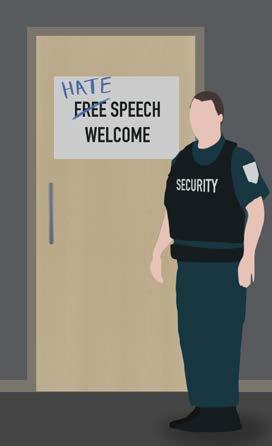
SSI looks irresponsible at best and comfortable cozying up to right-wing quacks at worst.
SSI’s post suggested that, because their group represents “less than 0.2 per cent” of the global population, the decision to suspend them encourages a climate of antisemitism. The Jewish community is not a monolith, and suggestions that all Jewish people must be aligned with SSI are antisemitic. Jewish U of M faculty and students have even published writing critical of Israel in the Manitoban in recent months, so there really isn’t a justification for a U of M student group to erase or ignore the Jewish community’s diversity of opinions.
plenty of pictures.
remained resolutely tightlipped.
What is outrageous is not just that the U of M and UMSU have been negligent in preventing and addressing Islamophobia and anti-Palestinian racism on campus, it’s that the U of M has been complicit in contributing to that atmosphere while UMSU washed its hands of advocating for students affected by that complicity.
For instance, certain members of security services have been emboldened to posture and role play ‘80s comic book bad cops, threatening to arrest innocent Muslim students before following a Palestinian teenager out of their zone of authority. It’s entirely within the U of M’s jurisdiction to conduct some kind of inquiry into Islamophobic or anti-Palestinian bias latent in security services’ personnel, and yet what is it doing?
Well, it’s preparing to dialogue, according to Schnarr, in “upcoming series events.”
ops of their relative value, like obnoxious tourists armed with selfie sticks photographing themselves against the backdrop of their own negligence.
In December, I wrote about the ways that I felt UMSU president Tracy Karuhogo’s administration’s silence on the genocide of Palestinians was part of the student union’s long tradition of prioritizing its executives’ interests over carrying out the union’s actual duties. I do think that UMSU’s silence on Palestinians’ plight communicated to groups like SSI that the community was hospitable to, if not entirely permissive of, anti-Palestinian racism.
It’s not even out of the ordinary for UMSU to comment on international affairs. As recently as 2020, UMSU voted to officially call for a “de-escalation of tensions in the Middle East” when the U.S. and Iran seemed poised for nuclear war. They also once adopted the International Holocaust Remembrance Association’s (IHRA) definition of antisemitism and stripped Students Against Israeli Apartheid of their UMSU status.
UMSU’s condemnation is belated, and an entirely reactive approach representative of the student union’s lack of forward thinking. Much like a parent mopping up their toddler’s vomit after feeding them a diet exclusively of chicken nuggets, gummy bears and genocide apologia.
Beyond bravely expressing disapproval for a form of hatred, what tangible action have UMSU’s and the university’s leadership been taking? They’ve been posing for
Vice-provosts Laurie Schnarr (students) and Tina Chen (equity) stood with Arij Al Khafagi and Elmoudi for a photo posted to Instagram. U of M president Michael Benarroch was noticeably absent, maybe because his brother was a primary emcee at the “Hear Our Voices” event in late January.
But, of course, doing more would require the U of M, and possibly even UMSU, to acknowledge the centrality of anti-Palestinian racism to this debacle. Security, in assuming Nakhleh’s keffiyeh — a symbol of solidarity with Palestinians — indicated she was a troublemaker made abundantly clear that there is an interplay between Islamophobia and anti-Palestinian sentiments here.
UMSU’s silence on Palestinians’ plight communicated to groups like SSI that the community was hospitable to, if not entirely permissive of, anti-Palestinian racism
Schnarr’s presence in these photos constitutes its own comedic reward. I wrote in January criticizing an email on which Schnarr was the primary signatory, as the email crassly squeezed an acknowledgment of the police killing of Afolabi Stephen Opaso between New Year’s greetings and announcements about UMSU breakfasts.
Yes, UMSU and U of M are right to do the bare minimum and condemn Islamophobia. But there needs to be tangible action, along with acknowledgements that this came too late. Both parties’ performative displays ring particularly hollow in the wake of the U of M’s suspension of Al Khafagi, throughout which UMSU
Condemning “all forms of discrimination” as the U of M and UMSU have done is important. But there’s a reason that, at times, we call for focused attention on specific kinds of racism. Stop Asian-American and Pacific Islander Hate, Black Lives Matter — we say these things when people in these specific communities suffer violence, because there are idiosyncratic forces that affect specific people in specific ways.
Eid’s outburst was Islamophobic, but he was also given a platform because there is a rampant problem with anti-Palestinian racism in the U of M community. The event was predicated on genocide denial, with Eid’s premising question being “what led to the war between Israel and Hamas?” repeating popular narratives that represent the genocide of Palestinians as a “war.”
To not acknowledge that basic element drains even these performative photo-
This is what leaves a sour taste in my mouth as I review both the U of M’s and UMSU’s statements on Eid’s talk. Imagine pressing your leadership on the question of whether or not they condemned misogyny in the wake of a highly publicized attack against women, only for them to respond that they condemn all instances of gender-based discrimination. You would be right to call that answer evasive.
When I reflect back on previous UMSU presidencies, I remember only serial humiliations, like then-UMSU president Jeremiah Kopp misusing $29,000 of the union’s funds on couches and food, or Sid Rashid’s 2010 administration allocating funds to create a special parking pass for UMSU executives.
We seem to have reached the great stain on Karuhogo’s administration’s professional vest. Although the student union had five months to model itself after its predecessors’ successes, it seems that Karuhogo and her team opted to book a space in the student union’s hall of fumbles.
11 comment@themanitoban.com March 06, 2024 Comment
graphic / Teegan Gillich / staff
Is it just men hating women, or is there more to it?
Internet conglomerates contravene the cause of feminism
Lakshmisree Shaji, staff
Those who have ever had the misfortune of coming across the animated meme of two men sharing tea, saying “women” and laughing maniacally will have likely watched the origin of the insulting meme “women (followed by a tea emoji)” which probably happened around 2022.
Readers may also have noticed “women tea” comments under videos of women where they are doing something supposedly wrong. These videos might show women not knowing what cryptocurrency is or making mistakes, trans people being misgendered or girls doing something silly.
The possibilities are limitless when the internet decides to pass the same misogynistic comment. These videos have gained millions of views, and the mimetic insult has become part of internet lingo that is universally used to shame women.
I don’t want to mock the misogynists who partake in this derogatory meme culture, lecture them or even sympathize with them. I just want to try to understand why they think it is acceptable to litter
the internet — and real life — with vile and patriarchal ideas.
Although not drastically different from all the other misogynistic things I have seen on the internet since its inception, this constant and publicly displayed hatred is sickening. The mere thought that people are capable of spewing hatred every day should not be surprising at this point, but it is certainly leaving many of us completely hopeless.
Hopelessness reminds me of Mark Fisher’s Capitalist Realism: Is There No Alternative? That was probably the first critical work that my 2017 nihilistic self found solace in, so rest assured that I am no class-reductionist.
Capitalist realism, according to Fisher, is “the widespread sense that not only is capitalism the only viable political and economic system, but also […] it is impossible even to imagine a coherent alternative to it.” As long as patriarchy and settler colonialism are directly involved in decisions that are made around the world, I don’t think I’m far off equating these harmful ideologies with capitalism.
The manifestation of these ideologies in our everyday lives is certainly different compared to capitalism. Still, when gender equality for women and queer folks is considered a utopian idea, it certainly makes me wonder if the alternatives to patriarchy — which, to many of us, is as simple as a day on the internet without being constantly attacked — are unattainable.
Fisher uses the term “responsibilization,” which was coined by Judith Butler, to make the argument that many of us are passive spectators and first victims of climate change. Therefore, individuals are not responsible for global warming. Rather, the responsibility of it lies in an “impersonal structure.”
For Fisher, this structure is capitalism and its machinery, which includes every big corporation. To me, a 24-year-old cis woman who sometimes reaches the verge of a breakdown after a few hours of scrolling on social media and exposure to online misogyny, the impersonal structure is patriarchy and settler colonialism.
Social media certainly facilitates the spreading of these ideas that result in the

infantilization of women and queer folk, domestic abuse, workplace harassment and more.
So, after careful analysis of the flaws of society and considering my mental health, I have stopped arguing with incels on X (formerly known as Twitter). It only ever ends in slut-shaming and me deleting the app, but that is beside the point.
We need to be able to make fundamental, structural changes before dealing with those who are violently anti-women.
We need systems in place that will hold Alphabet, Amazon and Meta accountable for their actions that are capitalistic and therefore primarily patriarchal and colonial.
When tangible structural changes improve the online experience for many of us, we will have more faith in a society that treats us equally. Hopefully, then, we can collectively kick the butts of incels.
My identity is more than two halves Bisexual and Métis identities are distinct, not blends of something else
Braden Bristow, staff
I came out as bisexual when I was around 13. I understood myself as half-gay. A year before I came out, I became a citizen of the Manitoba Métis Federation. I understood being Métis as being half-Indigenous. While I am still bisexual and, obviously, still Métis, I was incorrect about what either of these identities were.
The term “half-gay” is important to unpack, as it has a lot to do with my conception of what bisexuality meant at the time. When I came to terms with my sexuality, I understood it as meaning attraction to both men and women. The logic I had in my head was that a man liking women is heterosexual, and a man liking men is homosexual. Therefore, bisexuality is half-homosexuality and half-heterosexuality.
There are a few problems with this definition, but as a 13-year-old it made a lot of sense. First, I am not exclusively attracted to men and women. Second, being bisex-
ual does not halve my attraction to women, nor is my attraction to men half of what a homosexual person would experience. Being bisexual is a unique sexuality itself.
A more accurate description of my sexuality is that I am open to attraction towards any gender. Of course, this realization came about after years of experience along with the small amount of wisdom that comes with my advanced age of 22.
Of course, how I understand my sexuality may very well differ from how someone understands their bisexuality. I am far from an authority on sexuality, but I do know that no matter how someone identifies they are more than just two parts of something else.
My Métis identity is not dissimilar in the way I came to terms with it. Because the Métis ethnocultural group has its origin as a mixed ethnic group, I interpreted to mean I am a mixed person. When someone asked me what I was, I told them I was half-white and half-Indigenous. While I
do have mixed ancestry, my family is distinctly Métis in our culture and community connections.
To be Métis is to have a distinct unique ethnocultural identity. Métis music, dance, food, language, community and culture are inspired, yet distinct from their First Nations and European roots. Elements of Métis culture borrow from its mixed roots.
For example, the language spoken in many historically Métis communities, Michif, makes use of French nouns and Cree verbs. However, like other parts of Métis culture, the aspects of mixedness present in the Michif language come together to form a new whole rather than two halves.
An entire ethnocultural group cannot be reduced to simply being half of two races. The Métis people are a synthesis of centuries of culture and history. I am not half -white or half-Indigenous, I am wholly Métis.
Taking unique identities then conceptualizing them into being made up of two

graphic / Teegan Gillich / staff other things is an extreme oversimplification. On the surface it likely seems as though there is nothing inherently wrong with understanding these two identities as being constituted of two halves. However, when one takes the time to look more closely at these identities, there is much more than what is on the surface. The association with sexuality or ethnocultural identity as being half of something else is reductive.
For people who are queer, and/or racially or culturally mixed, sometimes identifying as two halves when speaking to others is helpful. It can be difficult to summarize one-
self to those who do not have the understandings and experiences critical to making sense of their personhood. Identities, like people themselves, are not puzzle pieces that can be taken apart, they are unique complex concepts.
If our conception of Métis or bisexual identity is simply that to be either is to be made up of two halves, then that idea should be dispelled. Thinking about people as percentages or fractions isn’t just reductive, it impacts our ability to understand others.
12 comment@themanitoban.com Vol. 110, No. 24 Comment
graphic / Dallin Chicoine / staff
Re: ‘Feminism and genocide: a reflection on ‘Hear our Voices’’
Deborah Schnitzer
Iread with interest the article in the Manitoban, “Feminism and genocide: a reflection on ‘Hear our Voices’” by Dana Medoro and Serenity Joo. Written in collaboration with the Manitoba chapter of Faculty for Palestine it responds to the presentation, “Hear Our Voices: Shedding Light on Sexual and Gender-Based Violence in the October 7 Hamas Terror Attacks,” given by the former Director of Israel’s Authority on the Advancement and Status of Women, Ayelet Razin Bet Or.
As a human being, a woman, a feminist, a Canadian and a Jew, I underlined the importance of two of their observations: “truth is one of the first causalities of war,” and “misinformation campaigns […] comprise a particularly horrendous, one-sided siege.” It would follow that the “truths” given on both sides might be equally subject to scrutiny.
However, one-sidedness prevails. Israel is repeatedly characterized as a nation guilty of an “imperial project” a “global propaganda machine” spreading “misinformation,” responsible for “the frightening Zionist suppression of dissent across university campuses,” a “genocidal government” that is “appropriating […] activist rhetoric,” and “exploiting women” to “demonize and justify annihilating Palestinians.”
If truth is a casualty of war, what does this characterization of Israel represent? If, as the authors claim the “Israeli government’s lies about the occupation of Palestine” provide “a record of disinformation and violence” that is “clearly demonstrated and factchecked,” how can that claim stand if “misinformation” in war is a “campaign” initiated by both sides? How can “truth” and “fact,” crafted to denounce but one side have merit?
I wondered further: why in this article is Hamas named a “militia” that “attacks” rather than, let’s say, a terrorist organization whose genocidal policy requires the annihilation of the state of Israel and inspires the massacre of around 1,200 people, the sexual torture, mutilation and rape of women and girls, and the hostage-taking of over 240 people?
If, as the authors claim, a “truly feminist philosophy would not divide ‘us’ from ‘them,’” how can their argument do anything but divide — obliterate the possibility for the actual investigation of both sides, of the variety of truths, facts, representations, actions, histories and narratives that strive to comprehend the complexity of the Middle East?
If the “us” and “them” arguments the authors construct breed sidedness of the most reductive kind, what kind of feminism are the authors manifesting? They claim
that gender-based violence against Israeli women “not being heard” has nothing to do with antisemitism or silencing because these “voices are being ventriloquized to shore up support for a genocidal government.”
Further, they note that as the story of beheaded babies has not been proven (though the burnt, bullet-riddled infant and child bodies, the mutilated and beheaded adult bodies cannot be disputed given the existing recordings of the massacre and the forensic evidence), Israeli women’s accounts, their “very real testimonies” are “overshadowed” by Israeli propaganda, “compromised” by “evidence” that is not “sound.” The “accounts of mass rape” don’t “platform.”
While authors state they “do not disregard Israeli women’s testimonies,” would claiming that the “silence” can be justified by using accusation (“genocidal government”), rationalization (“compromised,” “ventriloquized”), and ranking (“overshadow”) not suggest profound disregard?
Who determines what evidence is “sound?” If the testimonies are “very real,” what further justification of their legitimacy is required? Why would they not be heard? Why would they not “stand on their own?”
While feminism, according to the authors, is unhindered by loyalty to nation, “feminists do not base their politics in nationalism” nor “exclude
the voices of other women,” I wonder: is it possible to erase nation as a key component of the crisis in the region?
Is the feminist cause the article embraces on behalf of Palestinian suffering not deeply embroiled in issues of nation in a war dependent on the premise that Israel has no right to exist and Palestine does? To what extent is the demonization of “them” by claiming “Israel is exploiting women and appropriating Black feminist and activist rhetoric in order to demonize and justify annihilating Palestinians” not expressive of exclusionism?
For the authors, Razin Bet Or has no right to claim solidarity with the vision and practice of #MeToo and Black Lives Matter movements. Her feminism rests on an “unacknowledged borrowing,” an “appropriated […] rhetoric.” Can an event named “Hear Our Voices: Shedding Light on Sexual and Gender-Based Violence in the October 7 Hamas Terror Attacks” not focus on the experience of Israeli women and girls who have been raped and assaulted? As this is the focus, is Razin Bet Or’s feminism “distorted” and thus dismissible?
In the midst of the evolving tragedy within Israel and Palestine, I consider to what extent are we all obliged to engage in civil, tempered, careful, and as much as we are able, informed discourse? How do we become informed? Who are those who
have devoted themselves to the study of the many sides, to the wide-ranging “facts” and “truths” lived within this region? How do they talk to one another? Should we educate ourselves so that we might listen to what they have to say, how they say it, and how they talk civilly with one another?
Finally, what kind of literacy is brought when we rely on dividing realities into “us” and “them,” though, as the authors themselves note a “feminist philosophy” involves itself in a “common allegiance rooted in abolishing patriarchy, demanding the end of violence and oppression,” “and “especially the “dismantling of the military industrial complex.”
I am indebted to my wondering, thinking, and feeling self. I refuse the name-calling that so debases, so bludgeons the “them” the “us” is in danger of being unheard, that so insists on the divide between “us” and “them” that a “common allegiance” to common bonds — which must include the survival of both Israelis and Palestinians — remains forfeit.
Deborah Schnitzer, National 3M Teaching Fellow, Professor Emerita, Department of English University of Winnipeg

13 letters@themanitoban.com March 06, 2024 Letters
graphic / Dallin Chicoine / staff

To complete Sudoku, fill the board by entering numbers 1 to 9 such that each row, column, and 3x3 box contains every number uniquely. In Straights, like Sudoku, no single number 1 to 9 can repeat in any row or column. But rows and columns are divided by black squares into compartments. Each compartment must form a “straight.” A straight is a set of numbers with no gaps but it can be in any order, eg [7,6,9,8]. Clues in black cells remove that number as an option in that row and column, and are not part of any straight. Glance at the solution to see how “straights” are formed.
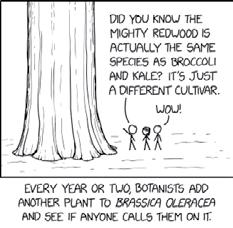
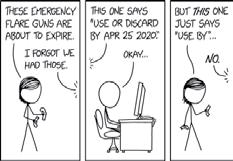

Diversions 14 graphics@themanitoban.com Vol. 110, No. 24
Straights Puzzle by Syndicated Puzzles Puzzle by Syndicated Puzzles Vol. 110, No.24 graphics@themanitoban.com Sudoku Sudoku Solution Straights Solution Diversions xkcd.com xkcd.com xkcd.com 2024 Alance AB 71 95 2 61 6453 74 7 3 3 36 4 5 1 9 2 © 2024 Syndicated Puzzles 34126 6 947 51 5238 92 871 1 63592 © 2024 Syndicated Puzzles STR8TS Easy How to beat Str8ts –SUDOKU To complete Sudoku, fill the board by entering numbers 1 to 9 such that each row, column and 3x3 Tough 45 64532 21 21 35214 65 2 1 453 36 © 2024 Syndicated Puzzles 34126 6 947 51 5238 92 871 1 63592 © 2024 Syndicated Puzzles Easy any row SUDOKU To complete Sudoku, fill the board by entering Tough 45 64532 4521 21 35214 21 65 3 934127685 671358249 825964713 467583192 512479368 389612574 258791436 793246851 146835927 2187 48965732 3287956 19876 4537689 64573 7823465 32185647 6743 36 4 5 1 9 2 Str8ts Solution Sudoku Solution 934127685 671358249 825964713 467583192 512479368 389612574 258791436 793246851 146835927 21 48965732 32 1 453 645 78 32185647 67 36 Sudoku Solution Provided by: Teegan Gillich 12 by 50 orthogonal maze Copyright © 2024 Alance AB, https://www.mazegenerator.net/
‘La Vie Boheme’ of the musical theatre ensemble
Desautels faculty of music students gear up for showcase at the Gas Station
alison holliday, staff
The musical theatre ensemble is one of many ensembles tucked away in the practice rooms of the Taché Arts Project.
The course is open to auditions from any student who wants to learn to sing, dance and act under the guidance of director Donna Fletcher.
Under that same guidance, this batch of musical theatre ensemble students will be released from their practice room to perform their yearly cabaret showcase of various scenes from different musicals, written and composed by the ensemble students themselves at the Gas Station Arts Centre on March 9 and 10, called La Vie Bohème.
The showcase is a curation of scenes from the musicals
Anne of Green Gables, Hamilton, Little Shop of Horrors, Little Women, Phantom of the Opera, Rent, Something Rotten and The Sound of Music
Between rehearsals, tight schedules and feverish excitement, students preparing for the Saturday performance are working hard to balance their courses and their passion for the ensemble.
Second-year voice major and ensemble member Lizzie Rochon said that her favourite part about it is the hard but rewarding and fun work that comes with musical theatre, like singing, dancing and act-
ing.
“It’s challenging and so specific,” she said, praising the program’s director as well.
“[Fletcher is] a really, really good acting coach. The intention she brings and the ideas she has, advice she gives, is so specific and so helpful.”
Rochon says that the ensemble is a very practical class for musical theatre students, as it gives them a glimpse into the professional theatre world.
Isabelle Buisson, first-year ensemble member, cites the music program as a whole for providing more performance opportunities, “even just seeing performances. It’s just like constant music.”
Fletcher has brought in multiple professional artists to help build the showcase — one dance number is choreographed by Samantha Hutchings, a musical theatre instructor at the Royal Winnipeg Ballet, and another by Shauldon Santos, who performed at the Bahay Kubo Sessions in January.
Meanwhile, the musical direction is curated by Rachel Cameron, who has been music director for Rainbow Stage and Dry Cold Productions.
Buisson describes many scenes of the showcase as connected by a theme of lightheartedness.
Alongside the opportunity to work with professional
artists provided by the class, Rochon and Buisson both emphasize the work Fletcher puts into the showcase as director — from cultivating costumes and collecting props to coaching, Fletcher is at the core of this production.
“I feel like I just learn so much from her,” Rochon said.
The ensemble, brimming with opportunity, is also accessible to all kinds of students.
Ranging from engineering to science and more — students’ faculty of origin doesn’t bar them from becoming an ensemble member. When the spotlight hits, everyone is a performer regardless of their faculty.
Buisson joined the musical ensemble after transferring from the faculty of arts. Despite never having the chance to do musical theatre before university, they found a sense of togetherness in the ensemble.
Buisson told the Manitoban “the collaboration with all the other students is really fun […] Someone has one idea, and then another person has another idea until the scene turns into something even greater than you could have imagined.”
Rochon recalls being warned of loneliness before beginning at the University of Manitoba. She was recommended to get involved
’Toban Listens: Poetry Unbound
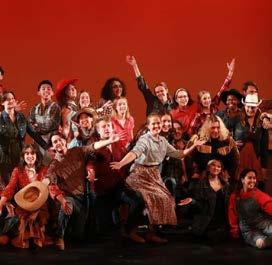
with clubs but finds that “you kind of don’t have to in music ‘cause it’s built in.”
Getting to be a part of the ensemble and participating in her first showcase is, Buisson feels, like “a childhood dream coming true.”
The showcase isn’t just for light-hearted musical theatre seekers. “It has something for everyone,” Rochon said, regarding selling the idea of attending the showcase to students outside the faculty.
The showcase features a variety of different musical theatre styles and scenes. “It’s got Phantom of the Opera for kind of your classic musical
Recommended by writers and Irish musicians everywhere
Jacob Davis, staff
Poetry Unbound wasn’t the first podcast I listened to, but it certainly was the podcast that inspired a new kind of love in me for the platform.
I was introduced to it through globally adored Irish musician Hozier, during a Q & A on Instagram during the COVID-19 lockdowns.
Between virtual classes and looking for part-time work that was essentially non-existent, I found myself craving connection and longing for creative outlets I used to enjoy, like writing poetry.
I started listening to Poetry Unbound initially to seek out some inspiration, but I found so much more in it.
Poetry Unbound is a poetry podcast, hosted by Pádraig Ó Tuama and created by The On Being Project, in which the podcast takes listen-
ers through a journey of dissecting and exploring a single poem per episode, with commentary from and about the author as well as personal analysis.
The show has eight seasons, but listeners could start anywhere in my experience.
A technique I use is downloading a bunch of random ones and putting them in my shuffle.
Ó Tuama is such an engaging yet soft-spoken poetry companion that even poems I may have initially thought of as out of my area of interest become engaging through his oration.
The first episode I tuned into was “Aria Aber — The Only Cab Service of Farmington, Maine,” a poem by Aria Aber about sitting in a taxi with a driver who was in the forces and stationed in
Afghanistan, where the passenger is from, and the complex drive the two of them take.
Ó Tuama recites the poem after relating to it with his own experiences. The way he does this and how he understands poetry could be an episode all on its own. He’s so interesting, and the biggest joy with this podcast is listening to poetry from all sorts of authors with someone who so clearly adores it.
It never feels like a chore to sit through Ó Tuama, whether it’s reading, relating or sharing the life of the author for that episode.
Another aspect of the podcast that I love is how the poem is recited twice, the second reading occurring at the end of the episode, leaving listeners one last time to reflect.
theatre, it’s got Little Shop of Horrors, it’s got [...] The Sound of Music. It’s got a whole bunch of different ones.”
Buisson said she hopes the audience will “feel the sense of community that is in the ensemble” while watching the performance.
The showcase runs March 9 at 7 p.m. and March 10 at 2 p.m. at the Gas Station Arts Centre. Tickets are $12 for students and $20 for general members of the public. For more details, visit https:// eventscalendar.umanitoba. ca/site/music/
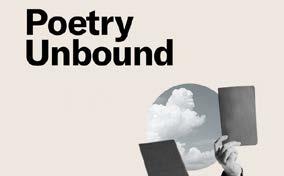
It’s also refreshing to be exposed to poetry by diverse poets from around the world and from different walks of life.
Poetry Unbound not only introduced me to these new artists but also had me seeking them out.
I was no longer satisfied
with the generic old literary works given to me at school. I wanted something more, something intimate and human.
All in all, that’s what Poetry Unbound provides — intimacy and humanity in its rawest and earnest forms.
15 arts@themanitoban.com March 06, 2024 Arts
& Culture
photo / provided
photo / provided
U of M women book ticket to CanWest final
The University of Manitoba swept UFV in the CanWest semi-finals
Quinn Mayhew, staff
The Bison’s women’s volleyball team competed against the University of the Fraser Valley (UFV) Cascades in the CanWest semi-finals this past week.
The U of M crushed the first game of the best-of-three semi-final series against UFV.
Julia Arnold, the herd’s libero, was on fire during the game, setting a CanWest playoff dig record with 24 digs, helping the team beat Fraser Valley for the first time in two years.
The first set started off rocky for U of M, as the Cascades lead 13-12 out of the gate.
The herd rallied by calling a timeout, which led to a Cascade service error.
The Bisons managed to come back from this tough start, capturing the first set 25-19.
In the second set, the Cascades took an early 4-0 lead,
as the U of M struggled to defend against Fraser Valley’s unstoppable hitters.
Light Uchechukwu really pulled through, however, as she found her mojo alongside Katreena Bentley, allowing the Bisons to pull ahead of the Cascades.
In the second set, the U of M escaped with a 25-23 win over UFV.
The third set started with the Cascades attempting to make a comeback, but those plans were quickly dashed by Arnold, Bentley and Ella Gray who all made great digs to keep rallies going.
Consequently, the third set finished with the Bisons edging Fraser Valley 25-16 and sweeping the Cascades in three sets to win the game.
The second game was evenly matched in the first set, as both teams were grinding out the offensive and defensive side of play.
Eve Catojo took the initiative in the first set, accumulating three out of her eight blocks in the game.
Ultimately, the University of Manitoba closed out the first set 25-21, leading Fraser Valley 1-0.
The Bisons then took the reins in the second set but were met with a pushback from the Cascades, who won the set 25-21.
The herd really struggled in the third set, making it possible for Fraser Valley to pull ahead.
The Cascades were on a roll, scoring ten points in a row as Lauren Attieh’s presence at the service line proved indispensable.
Fraser Valley had 13 aces compared to the U of M’s five.
The herd ended the third set, losing badly to UFV 25-14.
In the fourth set, Arnold performed multiple onehanded digs, setting a ten-
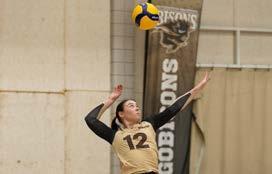
acious mindset for the rest of the set.
As the fourth closed out, the U of M pushed the match to five sets, as they stole the set 25-19.
In the fifth, the herd had all the momentum and was fueled by its stellar defence.
The Bisons backed the Cascades into a corner in the fifth.
Ultimately, the U of M ended the fifth set by winning
against Fraser Valley 15-7, thus booking its tickets to the CanWest finals for the first time in ten years.
In the CanWest finals, the University of Manitoba will compete against the University of British Columbia Thunderbirds on March 9.
Josh on the Jets: Bettman and the deadline
NHL commissioner visits, addresses ticket-sale concerns as trade deadline looms
Joshua Brandt, staff
As the Winnipeg Jets’ season careens along and the trade deadline fast approaches, the team has been placing consistently within the top 10 of the NHL standings. Accordingly, it seems poised to embark on a lengthy playoff run. Thus, the Jets’ prospects would seem balmy in an otherwise frigid city.
Nevertheless, according to a CBC report, “Winnipeg’s season-ticket base has decreased 27 per cent in three years from approximately 13,000 to just under 9,500.”
Moreover, in an interview with the Athletic, Mark Chipman — who is the Executive Chairman of the Board of True North Sports + Entertainment and of the Winnipeg Jets — insinuated that the Jets would like to acquire a season ticket base of 13,000 once again. He also said that the current state
of season ticket ownership is, “not going to work over the long haul.”
Chipman appears to be seeking the financial support of businesses primarily. However, he has even gone to the homes of former season ticket holders to encourage them to re-up personally.
Dissecting Bettman’s visit
Recently, the commissioner of the NHL Gary Bettman visited Winnipeg and fielded many questions about this potentially concerning depletion. It is worth noting that his visit had nothing to do with Chipman’s interview, however.
Currently, the Jets are drawing crowds of a little over 13,000 people per game, which is the second-worst per-game total in the NHL.
Yet Bettman expressed

mystification during a press conference about “the tensions that seem to have developed.” He told local media, “this is a place — Winnipeg — where hockey matters.”
Diffusing any angst about the possibility of another relocation, Bettman then said, “I’m not sure why people are now speculating that somehow [the Jets] are not going to be here.”
“I don’t view this as a crisis,” he told reporters. “But I do believe, as with any team and any market, there needs to be collaboration between the community and the fanbase and the club, and I believe, ultimately, it will be here.”
Like Chipman, Bettman appears to be putting the onus on the city’s corporations. While not ignoring the drop off in season ticket sales, he feels that attendance will improve.
“I have confidence in the organization and, as importantly, I have confidence in this community,” he said.
“Let’s be clear about something,” he stated, in what seems to have been a categorial attempt to assuage any lingering relocation trauma, “I believe that this is a strong NHL market, and it will adjust.”
It seems that there is no reason to fret, for while the Jets may be soaring up the NHL
standings, the team is firmly grounded in Winnipeg.
And if you feel like catching a game, by texting “STUDENT” to +1-888-606-5387, as a University of Manitoba student, you can access cheaper tickets. They are usually around $50.
Trade deadline moves?
The Jets have already made one major splash: acquiring a new second-line centre in Sean Monahan.
Monahan fetched a hefty price, however, as the Jets sent their 2024 first-round draft pick to the Montreal Canadiens in exchange for his services. Monahan will also be an unrestricted free agent at the end of this season.
Nonetheless, the move has been worth it thus far. In his first 12 games with the Jets, Monahan has scored eight times.
Might the success of his first move prompt general manager Kevin Cheveldayoff to make another one before the March 8 trade deadline?
I think it might. Although, internal addition is also a tenable option.
2019 first-round pick Ville Heinola had a breakout training camp and would have cracked the opening-day roster had it not been for an unfortunate injury.
Since recovering, Heinola
has been playing for the Jets’ American Hockey League affiliate, the Manitoba Moose.
He is a dynamic, smooth-skating offensive defenceman who might be able to give the Jets a boost should they hold their cards come deadline day.
But if they play them, I think Cheveldayoff should pursue the Ottawa Senators’ defenceman Jakob Chychrun, who is currently number 27 on TSN’s Trade Bait Board.
Chychrun is a quality offensive player and a plus defender. Additionally, he can play either side. He does, however, have a 10-team no-trade clause in his contract. Although if Winnipeg is not on it and the Jets trade for him, he would be under contract through the 2024-25 season, meaning he would not be a rental.
Ostensibly, he would take Nate Schmidt’s minutes, whom Winnipeg would look to move alongside Logan Stanley.
Ottawa certainly would not accept a trade for Chychrun involving either or both Stanley and Schmidt alone, meaning the Jets would likely have to dole out one of its top prospects, which is a steep price. It would be understandable, then, if this proposed trade never comes to fruition.
Sports 16 sports@themanitoban.com Vol. 110, No. 24
graphic / Teegan Gillich / staff
photo / Matthew Merkel / staff





































